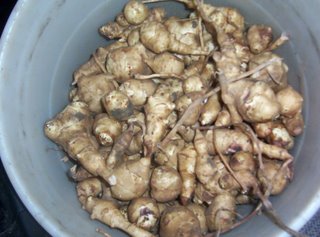
It was my pleasure to visit Ms. And Mr. Engel today in Westlake where they offered up a sizable bucket of Sunchokes. The Engels enjoy the flowering plant during the summer, and benefit from the underground bounty at the end of the warm seasons. Fortunately, the plants flourished, and they were able to share with me some of their homegrown Sunchokes.
Sunchokes might also be called sunroot, or Jerusalem Artichoke.
The name Jerusalem is due to folk etymology; when the Jerusalem artichoke was first discovered it was called Girasole, the Italian word for sunflower, as the plant is in fact part of the sunflower family. Over time the Girasole transformed into Jerusalem and since the root only faintly tastes of Artichokes, myself and most culinarians have recently started referring to the root as Sunchoke Sunchoke while still unique to the plates of most restaurant the plants are an important source of fructose for industry as they store carbohydrates as inulin instead of starch. The result is a very crisp and juicy root, the skin is completely edible when washed sufficiently. The easiest comparison is between sunchoke and jicama, with a shot of earthiness.

Mr. Engel urged me to put some Sunchoke in when making a pot roast. He told me as a flavoring only, they tend not to enjoy the soft, pastiness that is a result of a long cooking. Due to the fact the sunchoke breaks down thoroughly it is perfect for making a creamy soup. I like to take equal parts sunchoke and rutabaga, lay that over a few sauteed onions, cover with chicken stock, and when everything is soft, we blend it smooth. As Mr. Engle pointed out, the flavor of the sunchoke pairs well with red meat. I like to put a nice pat of butter down, and cook the cut Sunchoke on a rather high heat watching carefully not to burn the butter, while paying attention so the sunchoke doesn’t turn mushy. These caramelized Sunchoke are perfect with a grilled steak and mushrooms. The most refreshing way I’ve come to use sunchokes is part of a raw salad. You need a sharp mandolin as the sunchoke needs to be thinly sliced, then we cover it with a generous portion of lime juice, some chop bell pepper, olive oil, and a dash of hot sauce.
I really enjoy the unique flavor of sunchokes, they are sweet, earthy, and keep a pleasant texture. Unfortunately, they have a rather short shelf life, and I have not yet found any decant products that didn’t come from local farmers. I am very thankful to the Engles, as well as Ed and Betty Frank from Veggie Valley Farms in Sunnyville, Ohio. Ed and Betty brought me the absolute most wonderful sunchokes last year, and I couldn’t wait to get my hands on them again. I’m currently using them in my weekly specials, but they don’t last long.
1 comment:
A very important acquaintance has diabetes and I've heard that jerusalem artichokes, or sunchokes, mitigate that. So I'd like to grow some for him. I'd also like to play around with them to develop some recipes. Where can I get a few to put in the ground?
Thanks much.
Post a Comment